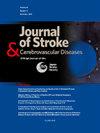通过颈动脉内膜-中膜厚度测量,访间心率变异性与动脉病变介导的心血管疾病之间是否存在关联?
IF 2
4区 医学
Q3 NEUROSCIENCES
Journal of Stroke & Cerebrovascular Diseases
Pub Date : 2025-05-14
DOI:10.1016/j.jstrokecerebrovasdis.2025.108348
引用次数: 0
摘要
背景:访间心率变异(HRV-VV)与死亡率和心血管事件相关。HRV-VV与血管疾病相互作用的机制尚不清楚。我们的研究旨在评估HRV-VV与颈动脉内膜-中膜厚度(IMT)之间的关系及其对心血管疾病发展的潜在影响。方法:研究人群来自Ebersberg社区脑血管疾病和痴呆初级保健干预项目(invasion)的老年患者队列。我们纳入了所有随访8年的患者,每两年定期随访5次。HRV-VV的定义为两次访间测量的标准差(SD)。使用单变量和多变量回归模型来确定HRV-VV、IMT与新发卒中和心肌梗死的联合心血管终点之间的关联。结果:2815例患者纳入研究。多变量分析HRV-VV与IMT呈正相关(p = 0.026)。每10 bpm的SD HRV-VV与IMT变化18±8µm相关。此外,HRV-VV与联合心血管终点呈数值正相关(p = 0.07),而HRV-VV和IMT同时升高比任何一个因素单独升高的可能性更大(p = 0.009)。结论:HRV-VV与早期动脉病变的替代标志物IMT呈正相关。这两个参数进一步证明了对心血管疾病发展可能性的协同影响。鉴于可穿戴设备持续监测的广泛可用性,HRV-VV可能为个性化心血管风险分层提供一个潜在的可修改的医疗目标。本文章由计算机程序翻译,如有差异,请以英文原文为准。
Is the association between visit- to- visit heart rate variability and cardiovascular disease mediated by arteriopathy as measured by carotid intima- media thickness?
Background
Visit-to-visit heart rate variation (HRV-VV) is associated with mortality and cardiovascular events. Mechanisms of the interaction between HRV-VV and vascular disease are not clearly understood. Our study aimed to evaluate the association between HRV-VV and carotid intima-media thickness (IMT) and their potential impact on cardiovascular disease development.
Methods
The study population is derived from a cohort of elderly patients enrolled in the primary-care-based INtervention project on cerebroVAscular diseases and Dementia in the community of Ebersberg (INVADE). We included all patients with a follow-up of eight years and five follow-up visits in regular two-year intervals. HRV-VV was defined by the standard deviation of between-visit measurements (SD). Uni- and multivariable regression models were used to identify associations between HRV-VV, IMT, and a combined cardiovascular endpoint of new onset stroke and myocardial infarction.
Results
2815 patients were included in the study. HRV-VV was positively associated with IMT in multivariable analysis (p = 0.026). Every SD HRV-VV of 10 bpm was associated with a change of IMT of 18 ± 8 µm. Furthermore, HRV-VV showed a numerical and positive association with the combined cardiovascular endpoint (p = 0.07), while a simultaneous increase in HRV-VV and IMT increased the likelihood more than either factor alone (p = 0.009).
Conclusion
HRV-VV showed a positive association with IMT, a surrogate marker for early arteriopathy. Both parameters furtherly demonstrated a synergistic impact on the likelihood of cardiovascular disease development. Given its widespread availability by continuous monitoring with wearables, HRV-VV may provide a potentially modifiable medical target for personalized cardiovascular risk stratification.
求助全文
通过发布文献求助,成功后即可免费获取论文全文。
去求助
来源期刊

Journal of Stroke & Cerebrovascular Diseases
Medicine-Surgery
CiteScore
5.00
自引率
4.00%
发文量
583
审稿时长
62 days
期刊介绍:
The Journal of Stroke & Cerebrovascular Diseases publishes original papers on basic and clinical science related to the fields of stroke and cerebrovascular diseases. The Journal also features review articles, controversies, methods and technical notes, selected case reports and other original articles of special nature. Its editorial mission is to focus on prevention and repair of cerebrovascular disease. Clinical papers emphasize medical and surgical aspects of stroke, clinical trials and design, epidemiology, stroke care delivery systems and outcomes, imaging sciences and rehabilitation of stroke. The Journal will be of special interest to specialists involved in caring for patients with cerebrovascular disease, including neurologists, neurosurgeons and cardiologists.
 求助内容:
求助内容: 应助结果提醒方式:
应助结果提醒方式:


